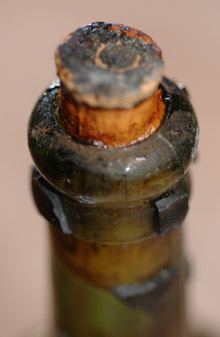
 This is my contribution to Session #36: Cask-conditioned ale that involves actual drinking of beer. Host Tom Cizauskas has the recap (plus plenty himself). I also wrote a little about cask ale in U.S. 15 or so years ago and posted an additional story (from 1997) in The Library.
This is my contribution to Session #36: Cask-conditioned ale that involves actual drinking of beer. Host Tom Cizauskas has the recap (plus plenty himself). I also wrote a little about cask ale in U.S. 15 or so years ago and posted an additional story (from 1997) in The Library.
This seems like a good Valentine’s Day story: Cask ale meets single hop. Together they make beautiful grapefruit and lemon aromas.
It’s a true story. I tasted it.
Marble Brewery in Albuquerque puts a firkin of cask ale on the bar every Friday. Il Vicino Brewery, also in Albuquerque puts a firkin out on Wednesdays. Turtle Mountain in nearby Rio Rancho regularly keeps a beer on cask. Friday I was at Marble because it was the first Friday of the month and time for The Session #36.
The plan Friday had been to serve a porter, but Friday morning it didn’t seem that would be in proper condition (have sufficient carbonation) and a cask of Centennial pale ale was also put on the bar.
The Centennial pale is not a brewery regular. In fact, you often won’t find a pale ale on. From the time the brewery opened less than two years ago Marble IPA has been the flagship. Because the 2009 hop crop has arrived the brewers at Marble made the Centennial-dominated beer to get to know how 2009 differed from 2008 (or 2009 from another field).
The only malt is pale and the beer is bittered with what brewers call CZT (Columbus, Zeus and Tomahawk are basically the same hop). Centennial hops are added 15 minutes before the end of the boil, at knockout and in dry hopping. (Quick aside, doesn’t dry hopping sound like a strange name for something involving liquid?)
“With zero specialty malts we can truly discover what that hop is all about,” said brewmaster Ted Rice. Next they’ll do the same with a Simcoe pale ale. In other words, he wants to know how these hops may best serve Marble IPA, and the occasional Double IPA.
Friday the brewers were trying something different with Amarillo hops in the IPA, adding the Amarillo at different times in two batches in an attempt to get the best (tangerine) out of that hop and avoid the less pleasant (garlic).
Centennial poses no such problems. The pale ale “reinforced what we knew. It’s a flawless hop,” Rice said. “You can use it in the kettle, the whirlpool, dry hop with it, hop the hell out of a pale ale and it retains its drinkability.”
I didn’t think this is the same drinkability Anheuser-Busch InBev touts on billboards. Centennial pale brims with zesty lemon and grapefruit flavors, and of course finishes with a firm bitterness.
This was not a flat out perfectly conditioned cask ale. The foam could have been tighter, the bubbles smaller, the mouthfeel a little fuller, but I suspect Steve Hamburg would have given it high marks. Particularly since a cask pint was as bright as the keg version.
Let’s be honest — plenty of drinkers are going to prefer the keg version, a little cooler, more carbonation, a more straightforward hop experience. And the beer was not designed to be a particularly complex. Not with a single malt, one hop for flavor and aroma, and a yeast that mostly gets out of the way.
However in my opinion time in the firkin and the lack of top pressure made the beer more interesting. The cask version was softer on the palate, fruitier (both malt/yeast flavors and hops). “It allows the hop character to open up, to become more aromatic,” Rice said.
I love happy endings.
 Sean Inman has posted the theme for The Session #38. With Dark Lord Day 2010 right around the corner you should be able to figure out what he is aiming for.
Sean Inman has posted the theme for The Session #38. With Dark Lord Day 2010 right around the corner you should be able to figure out what he is aiming for.

